For the 2025 school year, there is 1 public high school serving 271 students in Putnam School District. This district's average high testing ranking is 2/10, which is in the bottom 50% of public high schools in Connecticut.
Public High School in Putnam School District have an average math proficiency score of 10% (versus the Connecticut public high school average of 33%), and reading proficiency score of 45% (versus the 53% statewide average).
Public High School in Putnam School District have a Graduation Rate of 90%, which is equal to the Connecticut average of 90%.
The school with highest graduation rate is Putnam High School, with ≥90% graduation rate. Read more about public school graduation rate statistics in Connecticut or national school graduation rate statistics.
Minority enrollment is 23% of the student body (majority Hispanic), which is less than the Connecticut public high school average of 55% (majority Hispanic).
Overview
This School District
This State (CT)
# Schools
3 Schools
219 Schools
# Students
1,164 Students
166,353 Students
# Teachers
98 Teachers
13,569 Teachers
Student : Teacher Ratio
12:1
12:1
District Rank
Putnam School District, which is ranked within the bottom 50% of all 197 school districts in Connecticut (based off of combined math and reading proficiency testing data) for the 2021-2022 school year.
The school district's graduation rate of 80-89% has decreased from 85-89% over five school years.
Overall District Rank
#155 out of 200 school districts
(Bottom 50%)
(Bottom 50%)
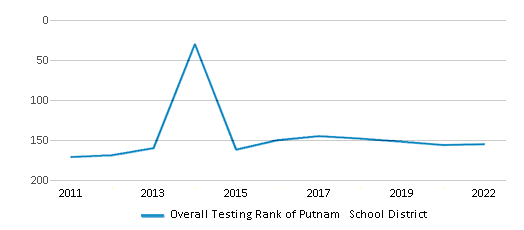
Math Test Scores (% Proficient)
31%
40%

Reading/Language Arts Test Scores (% Proficient)
40%
50%
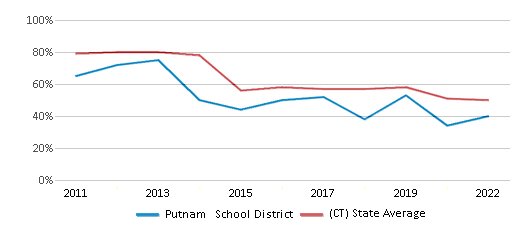
Science Test Scores (% Proficient)
35%
47%

Graduation Rate
80-89%
89%
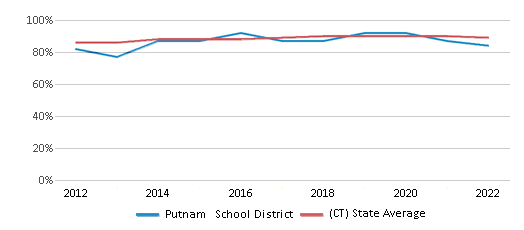
Students by Ethnicity:
Diversity Score
0.43
0.68
# American Indian Students
2 Students
426 Students
% American Indian Students
n/a
n/a
# Asian Students
15 Students
8,064 Students
% Asian Students
1%
5%
# Hispanic Students
202 Students
50,824 Students
% Hispanic Students
17%
31%
# Black Students
16 Students
24,621 Students
% Black Students
2%
15%
# White Students
857 Students
75,269 Students
% White Students
74%
45%
# Hawaiian Students
1 Student
165 Students
% Hawaiian Students
n/a
n/a
# Two or more races Students
71 Students
6,542 Students
% of Two or more races Students
6%
4%
Students by Grade:
# Students in PK Grade:
116
230
# Students in K Grade:
77
590
# Students in 1st Grade:
89
558
# Students in 2nd Grade:
108
566
# Students in 3rd Grade:
83
579
# Students in 4th Grade:
85
609
# Students in 5th Grade:
96
601
# Students in 6th Grade:
94
1,643
# Students in 7th Grade:
73
2,088
# Students in 8th Grade:
72
2,127
# Students in 9th Grade:
80
41,217
# Students in 10th Grade:
68
39,783
# Students in 11th Grade:
69
38,905
# Students in 12th Grade:
54
36,857
# Ungraded Students:
-
-
District Revenue and Spending
The revenue/student of $23,682 in this school district is less than the state median of $26,157. The school district revenue/student has declined by 6% over four school years.
The school district's spending/student of $23,182 is less than the state median of $25,225. The school district spending/student has declined by 6% over four school years.
Total Revenue
$28 MM
$12,920 MM
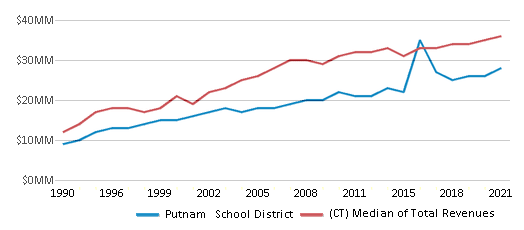
Spending
$27 MM
$12,459 MM
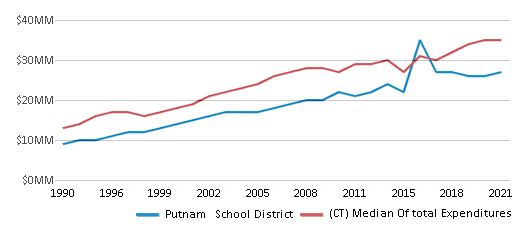
Revenue / Student
$23,682
$26,157

Spending / Student
$23,182
$25,225

Best Putnam School District Public High Schools (2025)
School
(Math and Reading Proficiency)
(Math and Reading Proficiency)
Location
Grades
Students
Rank: #11.
Putnam High School
(Math: ≤10% | Reading: 40-49%)
Rank:
Rank:
3/
Bottom 50%10
152 Woodstock Ave.
Putnam, CT 06260
(860) 963-6905
Putnam, CT 06260
(860) 963-6905
Grades: 9-12
| 271 students
Recent Articles

Year-Round Or Traditional Schedule?
Which is more appropriate for your child? A year-round attendance schedule or traditional schedule? We look at the pros and cons.

Why You Should Encourage Your Child to Join a Sports Team
Participating in team sports has a great many benefits for children, there is no doubt. In this article you will learn what those benefits are.

White Students are Now the Minority in U.S. Public Schools
Increasing birth rates among immigrant families from Asia and Central and South America, combined with lower birth rates among white families, means that for the first time in history, public school students in the United States are majority-minority. This shift in demographics poses difficulties for schools as they work to accommodate children of varying language abilities and socio-economic backgrounds.





